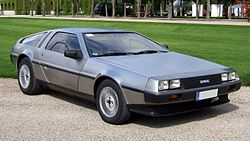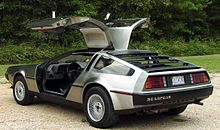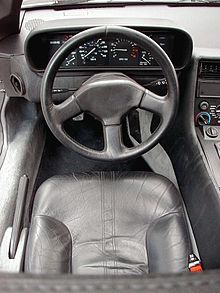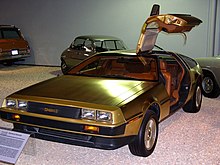DeLorean DMC-12
| DeLorean | |
|---|---|
|
DeLorean DMC-12
|
|
| DMC-12 | |
| Production period: | 1981-1982 |
| Class : | Sports car |
| Body versions : | Coupe |
| Engines: |
Petrol engine : 2.8 liters (97 kW) |
| Length: | 4216 mm |
| Width: | 1857 mm |
| Height: | 1140 mm |
| Wheelbase : | 2413 mm |
| Empty weight : | 1268 kg |
The DeLorean DMC-12 is a coupe and the only model built by the DeLorean Motor Company (DMC), which was built in Northern Ireland from spring 1981 to late 1982 . The car gained particular fame for its portrayal as a time machine in the film trilogy Back to the Future .
Model history
concept
John DeLorean said he wanted to build an “ ethical ” car - safe, durable and sustainable. Even as General Motors (GM) manager, DeLorean was of the opinion that compact, high-quality vehicles with powerful, efficient engines and significantly improved safety were the future. Because the rest of the management disagreed with this opinion, DeLorean, as Vice President of GM, began confronting his colleagues more and more often, which ultimately led to him being given the choice: to go voluntarily or to be fired. To save face, John DeLorean decided in May 1973 to quit GM in order to go into business for himself with the idea of a sports car under his own name (DMC - DeLorean Motor Company). The development of the technical concept at this early stage was carried out by Bill Collins, a former engineer at Pontiac .
Early on, DeLorean and Collins tried to implement their ideas of an "ethical car" by buying a safety concept from the "Allstar" insurance company and using it as the basis to create the first prototype of the DMC-12, which, however, was still DSV (DeLorean-Safety- Vehicle) was called.
As early as 1975, John DeLorean decided to have Giorgetto Giugiaro designed the shape of his car . The design was ready after a few months. It was not a completely new design, because Giugiaro was actually going back to a template that was once intended for the Porsche 928 , but had been rejected by Porsche. The shape was directly derived from Giugiaro's study Maserati Medici , a sensational work that later influenced vehicles as diverse as the Maserati Quattroporte III and the Audi Coupé Series I. The light rear section with the thin struts was based on Giugiaro's designs for the Maseratis Bora and Merak .
The first drawings from 1975 envisage a 2 + 2-seater version of the coupé - at least as an alternative design. It was ultimately not realized; DeLorean stuck to the two-seater design of the DMC-12. The idea of a four-seater was taken up again some time later in DeLorean's Medusa project.
Prototypes
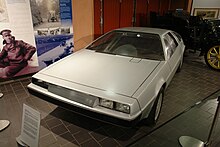
In February 1975, Giorgetto Giugiaro's company Italdesign in Moncalieri near Turin received the order to design the DeLorean car. In March 1975, Giorgetto Giugiaro showed his client John DeLorean and his chief engineer William T. Collins Jr. five different side views on a scale of 1:10 as well as some front views. In July 1975, just under six months after the order was placed, DeLorean and Collins saw the see-through model from Epowood and found it good. Epowood is a polyurethane block that can be processed with the hand tools normally used for woodworking. The advantage over wood is that it has no fibers.
The American company Kar Kraft then produced the first prototype, which was ready to drive in early 1977. The car still differed in detail - for example in the positioning of the rear-view mirrors and in the side windows - from the later production model, but apart from that largely corresponded to the specifications of Bill Collins and John DeLorean. It incorporated many of the safety features of the Allstar safety concept, so it was equipped with airbags, among other things. Initial engine tests with a Ford 3-liter V6 engine led to a dead end, and DeLorean relied on a four-cylinder engine from Citroën. The first prototype received the engine and transmission from the Citroën CX , which developed 75 kW (102 hp). However, no 5-speed gearbox was available for the Citroën engine, and the engine proved to be too weak, which is why DeLorean considered turbocharging. Citroën refused this with reference to warranty claims and resigned as a possible engine supplier.
In 1977 a second prototype was created, which was manufactured by Creative Industries . It had a 2.7-liter V-6 engine from Peugeot / Renault / Volvo (the so-called " PRV engine " or Europa engine), which Bill Collins had already noticed in the Renault Alpine A310 . The installation of this large, heavy engine meant that the entire rear half of the car had to be redesigned; a rear-engined car was made from a mid-engine car. Because the project was progressing very slowly and DeLorean was under increasing pressure from its investors, he decided - without consulting Bill Collins - to outsource the further development of the car.
In January 1979, the director of DeLorean Motor Cars Limited, which had recently been founded in Northern Ireland, Charles Bennington, and the purchasing manager Barrie Wills visited Italdesign. Giorgetto Giugiaro showed them his latest conceptual design, the Ace of Clubs ( Cross - Ass ). He pointed out that his four-year-old design was out of date and needed redesign. He recommended that the sharp edges should be rounded and that various characteristics of the Ace of Club should be incorporated. It was agreed that the right side of the vehicle should remain unchanged, while the left should be modified based on the recommended design changes. Bennington then only had to convince DeLorean of the changes required. The revised model was presented to him in April 1979, and the revised design was approved so that it could go into production in 1980.
Development at Lotus
DeLorean set aside two more years for development until it was actually ready for the market and launched. So he approached Porsche and asked for development to be ready for series production. However, Porsche refused on the grounds that development work on the vehicle would take at least five years; According to the Swabians, the project could not be carried out seriously within the time frame specified by DeLorean. As a fully liable sole proprietor, DeLorean was under increasing pressure. He had to develop his previously immature concept into an attractive, marketable product. The only car manufacturer who finally accepted the DSV in the allotted time was Colin Chapman and his British company Lotus .
In 1977 and 1978, 200 employees worked there at times to develop the DeLorean for series production. The previous technical developments by Bill Collins were largely abandoned, Collins himself gave up in frustration and resigned in early 1979. Lotus developed a completely different chassis, which was largely based on that of the Lotus Esprit . What was left of DeLorean's idea were only Giugiaro's design, the wing doors and the stainless steel-clad plastic body. The decision to adapt the technical backbone of the DeLorean to that of the Esprit is generally justified today with the tight time window that Lotus had for technical development: an independent construction of the DeLorean chassis would hardly have been possible in less than two years.
Lotus actually did the almost impossible and developed the "new" DeLorean in just two years. However, this left hardly any time to correct errors and foreseeable teething problems in the car. So the project was oriented even more closely to the Lotus Esprit.
The vehicle that Lotus ultimately presented was hardly a sports car in the true sense of the word. With a weight of around 1.3 tonnes and only 97 kW (132 PS) in the catalytic converter version, it lagged far behind the performance of competitor models such as the Corvette or the Ferrari . For many customers that was simply not enough for such an expensive vehicle, and they turned away, disappointed.
The restrained temperament was due not least to the economically sensible, but ultimately unfortunate decision in favor of the 2.8 liter PRV six-cylinder ( V-engine ) with Renault transmission, which made its long career for the large sedans from Peugeot, Renault and Volvo had started. The DMC-12 at least achieved a top speed of 200 km / h, which is surprising in view of the low performance and is probably due to the streamlined wedge shape. It was curious that the speedometer of the car only showed speeds of up to 85 mph (140 km / h) due to American laws at the time .
Serial production
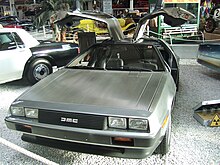
In March 1981, series production of the DMC-12 began in Dunmurry near Belfast in Northern Ireland , UK . The brand new DMC plant was built almost entirely through financial contributions from the British government, which wanted to reduce the high unemployment in Northern Ireland and at the same time prevent a further strengthening of the IRA . Previously, two cars had been made to test drive a total of just 60,000 miles to pass the US emissions test. However, this effort was too little to track down possible defects and to correct errors before the start of series production. The fact that DeLorean started production anyway was due to the growing pressure from investors and dealers who, after six years of waiting, wanted to finally make money.
Quality problems
The series vehicles suffered from fluctuating product quality before. Constant gap dimensions could not be expected, since the fiberglass tubs, which the car actually consists of, were exposed to relatively large tolerances in production. The manual adjustment and alignment of the stainless steel planks was therefore necessary and obviously not that easy.
Again and again the double doors gave cause for complaint. Although they did not require much space to open, they were too heavy in the case of the DMC-12. They were made entirely of stainless steel, overloaded with the electric motors of the window regulators , which opened only a tiny gap in the window surface, because the door was too rounded to sink the entire pane into it. With the magnetic switches of the central locking and the complicated linkage of the door locking, the door mechanism was very complex to set, which is why the wing doors often jammed or leaked after a while. Correctly set doors with new gas pressure springs , however, usually work perfectly and are far superior to other designs. Conventional wing doors rely solely on gas pressure springs. The door has to be lifted to open, and when closing the doors can cause painful injuries if they slip away from the passenger. In addition to the gas pressure spring, the DeLorean has a torsion spring installed so that the door swings open without external force when it is opened.
The engine fan system controlled by a temperature sensor was extremely vulnerable due to the Lucas on- board electronics used for cost reasons , which often led to engine overheating. Air conditioning systems that worked right away were rare, but it has now been found that most original systems still do their job today if they are correctly maintained and filled.
Many car magazines were disappointed with the concrete result of the daring and promising project. So many negative reviews followed, which also damaged the reputation of the DMC-12 with potential customers.
Sales problems, decline of the company
At the latest when DeLorean had production of the DMC-12 doubled in 1981 in order to be a successful businessman at the planned IPO of the new parent company DMH (DeLorean Motor Holding), the project began to collapse, because demand fell far below the previous production quota. Several hundred DMC-12s were in stockpiling in Belfast. When the British government at some point refused to inject any more money and DeLorean was arrested while trying to get additional capital through a cocaine deal (engineered by the US drug enforcement agency DEA ), the DMC went bankrupt. DeLorean was acquitted in the US for involvement of the DEA in cocaine smuggling, but in the UK he would have been tried for embezzlement, which would have put him in prison. Together with Colin Chapman , he had embezzled $ 17.5 million in investor money that he had put into other businesses and his lavish lifestyle. Since Chapman died in December 1982, he could no longer be charged. However, his CFO Fred Bushell went to prison for three years for involvement in the crime.
Because DeLorean stubbornly refused after the bankruptcy of DMC to transfer at least the worldwide distribution rights for his sports car, which he had secured from the beginning, so that it could continue to exist with a new investor in a small volume, it finally had to be liquidated causing 2,500 employees to lose their jobs.
After the factory in Dunmurry was closed, all metal parts of the manufacturing facilities, including the pressing tools, were auctioned to the highest bidder. Part of it went to a scrap dealer who sold the pressing tools for making the left front fender and right rear side panel to a fishing company. This used them off the Irish coast in the Atlantic as ballast for the nets of their fish farms. As a result, these two body parts are extremely rare today and correspondingly expensive. A large part of the bankruptcy estate was bought by former employees, who from then on dealt with the maintenance of the vehicles and the supply of spare parts.
Subsequent production and special vehicles
From the vehicle parts manufactured up to then, a few copies of the DMC-12 were assembled at the end of 1982. These vehicles are also known as the 1983 models. Ironically, shortly after the company's founder was arrested, the DMC-12 suddenly became hugely popular. A rush on the remaining vehicles began, which pushed sales prices up to over $ 50,000 in the short term.
Just in time for Christmas 1981, two vehicles were produced for the credit card company American Express and electroplated with 24-carat gold . On Christmas Eve 1982 the last vehicle was assembled from the remaining gold-plated parts. However, one door had to be gilded afterwards and is still recognizable today by the different color. All three vehicles are in the USA: One is in a casino museum in Reno (VIN 4300, brown interior, 5-speed transmission), the second in the Peterson Automotive Museum in Los Angeles (VIN 4301 black equipment, automatic transmission, too known as the car from the bank in Snyder, Texas) and the last built is privately owned in Maryland (VIN 20105, brown interior, automatic transmission). There are rumors about a fourth copy that is said to have been gilded by a private individual. In this context, it is also interesting that the DMC-12 were basically not painted, as the outer skin is made of unpainted, rust-free stainless steel, which gives it a unique appearance.
Of the approx. 9000 copies built, there are still around 6000 worldwide.
Famous owners of a DeLorean were or are:
- Jay Leno , American TV presenter ( Tonight Show )
- Johnny Carson , also a US television presenter; he invested $ 500,000 in the DeLorean Motor Company
- Sammy Davis Junior
- Patrick Swayze , the vehicle (built in 1981) of the actor who died in 2009 fetched a price of 81,000 US dollars at an auction in 2017
- Ace Frehley , the guitarist for the Kiss group
- Mike Candys , Swiss music producer
- Ernest Cline , American writer
Technical data and measured values
The following technical data and measured values were determined from cars, motors and sports :
| model | Cyl. (Engine) | Displacement | power | Torque | transmission | Empty weight | Acceleration 0-100 km / h | Maximum speed | Consumption per 100 km | Factory price |
|---|---|---|---|---|---|---|---|---|---|---|
| DeLorean DMC-12 | V6 (back lengthways) | 2849 cc | 97 kW (132 PS) at 5500 rpm | 220 Nm at 2750 rpm | 5-speed manual transmission or automatic (optional) | 1268 kg | 11.0 s | 198 km / h | 14.3 l | 74,797 DM (1982) |
media
The DMC-12 yet to legend was, he owed his appearance in the movie - trilogy Back to the Future , he passed through the to late fame. In this film, a fictitious nuclear reactor works in the rear of the car in addition to the combustion engine, which supplies energy for the " flux compensator " that enables time travel. In the fictional future, this will later be replaced by the fusion reactor "Mr. Fusion". The DMC-12, which flopped in real life, was just right for the filmmakers Robert Zemeckis and Steven Spielberg : At the beginning of the work on the film in 1984, it was still little known worldwide, looked very futuristic due to its extremely flat wedge shape and the stainless steel surface and was also to get cheap, because quite a few vehicles were still on the dump. In one of the first CGI - movie effects the car for which was screen through by George Lucas based company " Industrial Light and Magic " even brought to flying. With the success of the trilogy, the DeLorean achieved cult status .
Also in the Miami Vice episode In the Swamps from 1984 (original title Glades ) several DeLorean DMC-12s can be seen. In The Wedding Singer (The Wedding Singer) from 1998 with Adam Sandler and Drew Barrymore leaves her fiance also a DeLorean, and you can hear on the car radio, the Miami Vice theme.
In the series Matlock, Ben Matlock's neighbor comes under suspicion of murder because he let the murdered car dealer sell him a scrap-ripe DeLorean.
In the movie Rocky 3 , Sylvester Stallone poses in the DeLorean; and DeLoreans can also be found in films such as Police Academy , Beverly Hills Cop and The Boiled Rascal III .
In the B-movie Malibu Express by director Andy Sidaris , the protagonist Cody Abilene initially drives a red painted DMC-12.
In the animated series The Simpsons , the fictional unsuccessful actor Troy McClure drives in season 7, E19 Selma marries Hollywood star also a DeLorean.
In the anime series Hayate no Gotoku (English title: Hayate, the Combat Butler), in the 52nd episode, which ends the first season, the female protagonist Nagi Sanzen'in can be seen watching one of the back-to-back Watch future films where you can see the DeLorean on the screen.
In the film Donnie Darko , the DeLorean is also mentioned, the physics professor says: “The elementary principles of time travel are there. You have a vehicle and a portal. The means of transport can be almost anything, but probably a spacecraft. ”And Donnie replies,“ Like a DeLorean? ”
He also appears in the music video Dreams (Will Come Alive) of the dance project 2 Brothers on the 4th Floor from 1994.
In the music video for We Are All Made of Stars by Moby is seen briefly DeLorean in which the British actor Sean Bean sits.
In the music video for Good Morning by Kanye West , animated by Takashi Murakami , the "Dropout Bear" tries unsuccessfully in a floating DeLorean (clear reference to Back to the Future II ) to get to the graduation ceremony in time, but the engine fails.
In the animated series American Dad you can see the old Stan Smith high school , which is named after John DeLorean and has a huge DMC-12 double door as an entrance. In one episode, Stan Smith himself owns a DeLorean and, together with his son Steve, goes in search of a double door. Much of the humor in this episode stems from small allusions to the Back-to-the-Future films that Stan, unlike his son, doesn't know. He only owns the DMC-12 because he is an admirer of the company's founder, John Zachary DeLorean.
In Project Spymate: Secret Monkey in Action , Agent Mike drives a DeLorean.
In 2009, a DeLorean reappeared in the RTL series Alarm for Cobra 11 , episode geniuses among themselves .
In the television series Gilmore Girls , Lorelai Gilmore contemplates parting with her SUV and buying a DeLorean, but that doesn't happen.
In the second part of the first season of the British television series Ashes to Ashes , police officer Alex Drake is driven to the station by George Bonds in a DeLorean. The episode is set in London in 1981.
Another music video that features the DeLorean is the clip for the song Silly Boy by Eva Simons . In it the singer drives the car herself; and the extravagance of the double doors is also emphasized.
The music clip Dance by Music Instructor also features a DeLorean, with which the singer Holly Trance and the Music Instructor take a journey into the past.
A DeLorean appears in the Sat.1 series The Last Bull (episode cheating for beginners ).
On an episode of Two and a Half Men , Alan explains to Jake (while Back to the Future is on TV) what a DeLorean is.
In the music video Deer in the Headlights of the Owl City music project , singer Adam Young drives a DeLorean. The car shown in the video is one of the original vehicles used when filming the Back to the Future trilogy.
As part of the American series Sci Fi Science: Physics of the Impossible , presenter Michio Kaku drives one of the original vehicles from the Back-to-the-Future films.
In the music video Down McDonnelzzz at the band Electric Six are several DeLorean to see.
In the music video Thrift Shop by artist Macklemore , a DeLorean initially appears.
A DeLorean can be seen in the music video Hey Baby by singer Sean Paul .
In the song Glück by the German rapper Prinz Pi there is the text line “Get the DeLorean, let's go back with it”.
In the film A Million Ways to Die in the West , a quote from a DeLorean appears that Dr. Emmett Brown tries to hide so as not to attract attention.
In the movie Rock Of Ages , the DeLorean is parked next to the Venus Club run by Justice ( Mary J. Blidge ).
In the music video Take Her Place by Don Diablo ft. ARIZONA, producer Don Diablo works on a DeLorean and takes part in a race with it towards the end.
In the Amazon Prime series Pastewka , the DeLorean appears in season 8 , episode 4 (A Song of the Throat ).
In the film Ready Player One , the Avatar Parzival drives an animated DMC-12 decorated into a time machine.
In the animated film "Prollout" by Thomas Zeug, which was created on the home computer and mixed with real scenes, a Delorean is used in relation to "Back to the future".
Video games and slot machines
- In the game Carmageddon II , among other things, a DeLorean can be selected and driven as a vehicle. The name of the vehicle was garbled here in reference to the violent game content to De Gore on .
- In Autobahn Raser II , a DeLorean will be unlocked as soon as you have achieved everything that can be achieved in this game. There it is far superior to all other cars.
- There is a DeLorean in the games Resident Evil 2 and 3 .
- In the games Gran Turismo 4 for the PlayStation 2, Gran Turismo for PSP and Gran Turismo 5, as well as Gran Turismo 6 for the PlayStation 3 , the vehicle can be unlocked or purchased.
- In the game Scarface The World is Yours there is a modified version called "Dolphne".
- In the game Projekt Gotham Racing 4 for the Xbox 360 , a DeLorean is ready for export in Class G.
- In the game Redline for Mac OS X you can also activate a DeLorean and a floating DeLorean "Time Machine" after completing the respective driving missions.
- In the game Duke Nukem: Time To Kill for PlayStation 1, the DeLorean can be found in the cave level.
- In the game Interstate 82 the DeLorean can be found under the name "De Landau" and is also mobile.
- In the game Burnout: Paradise , the DeLorean is mobile as the back-to-the-future version "P12 Jansen 88 Special" - including a burning track and retractable wheels.
- In the game FlatOut 2 , a car similar to the DeLorean can be driven under the name "Fortune" in the racing class.
- In the Grand Theft Auto parts Vice City , Vice City Stories and Grand Theft Auto V Online a slightly modified version of the DeLorean can be found under the name Deluxo .
- In the game Avenue Flo , a diner dash offshoot, Flo passes businessman Derek with a green DeLorean on Spendalot Ave at the Pet Spa.
- In the game Driver: San Francisco it is possible to drive a DeLorean. If you accelerate it to 141 km / h (88 mph), the same speed as in Back to the Future , you unlock the mission "Encounter with the past", which is a re-enactment of the examination mission in the first part .
- The DMC-12 is available as DLC in the Forza Motorsport 3 and Forza Motorsport 4 games for Xbox 360 .
- In the game Enthusia Professional Racing for the PS2 you can also earn a DeLorean.
- In the game Asphalt 6: Adrenalin and Adrenalin HD for Apple devices it is also available after an update.
- In the game Asphalt 7: Heat for mobile devices it is available in class 1.
- In the Back to the Future pinball machine, a DeLorean modified as in the film is depicted on the backbox and on the sides of the cabinet.
- In the game Rocket League on October 21, 2015, the day Marty McFly lands in Back to the Future II , a supplement (DLC) was released in which you can control the car.
- In the game Deponia Doomsday , an original DeLorean from Back to the Future II appears in a café.
- In the game Car Mechanic Simulator 2015, a supplement (DLC) was published on September 19, 2016, where you can repair a DeLorean DMC-12, or become the owner of this vehicle yourself, in order to be able to prepare the car as you want it.
- In the indie game Hotline Miami , the protagonist drives a DeLorean DMC-12. This also occurs in the "Hotline Miami" DLC for the co-op shooter Payday 2 , where it serves as an escape vehicle for the players in the associated mission.
literature
- Michael Schäfer: Too early for the future - the DeLorean drama . Delius Klasing publishing house, Bielefeld 2011, ISBN 978-3-7688-3364-6 .
Web links
- Car Crash - The DeLorean Story , BBC 2004 (English)
Individual evidence
- ↑ a b Display board in the Ulster Folk and Transport Museum .
- ^ Epo-wood Delorean.
- ↑ Unsolved Mysteries: The Rest of The Story on the DMC Body Dies ( Memento from September 22, 2013 in the Internet Archive )
- ↑ 2012 on the Großglockner
- ↑ Texas DeLorean Club: DELOREAN VIN HISTORY
- ↑ DerWesten - derwesten.de: A piece of "Dirty Dancing" for 57,000 euros: You don't believe which film props were auctioned for so much money . April 29, 2017 ( derwesten.de [accessed April 29, 2017]).
- ↑ ECTO-88 is a recreation of the car driven by the main character in Ernest Cline's bestselling science fiction novel Ready Player One
- ↑ Auto Motor Sport 23/1982
- ^ Owl City: DeLorean News ( June 11, 2012 memento in the Internet Archive )
- ↑ Lyrics: Prinz Pi - Glück Lyrics. (No longer available online.) Magistrix.de, archived from the original on April 15, 2014 ; Retrieved April 14, 2014 .
- ↑ Rock of Ages (2012) - IMDb. Retrieved May 22, 2019 .
- ↑ MySpass: Back in the caravan - Pastewka. November 23, 2018, accessed June 4, 2019 .
- ↑ iTunes: Asphalt 6: Adrenaline , Asphalt 6: Adrenaline HD
12. (DeLorean 2017) http://www.autozeitung.de/delorean-dmc-12-2017-121073.html
